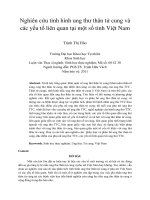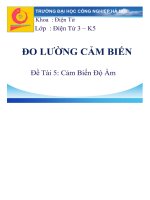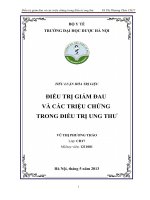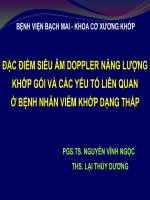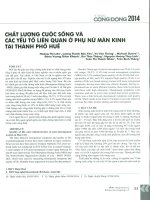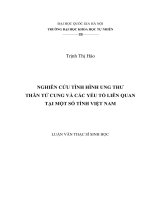Tiểu luận hóa lượng tử: Thuyết lượng tử Planck và các bài tập liên quan
Bạn đang xem bản rút gọn của tài liệu. Xem và tải ngay bản đầy đủ của tài liệu tại đây (596.71 KB, 23 trang )
HUE UNIVERSITY
THE UNIVERSITY OF EDUCATION
CHEMICAL SCIENCE
ESSAY
SUBJECTS: QUANTUM CHEMISTRY
TOPIC: “PLANCK'S THEORY QUANTUM AND RELATED
EXERCISE”
Lecturers:
Hoang Van Duc
Student:
Pham Thi Ngoc Diep
Code student : 18S2011005
Class: 3E
Hue, 5/2021
1
Contents
Introduction
For decades, quantum theory has quietly entered and enriched people's daily lives. Around us
there are applications of quantum theory such as laser technology, Ipod CD, computers, mobile
phones, ultra-thin TV screens... and many important applications in medicine.
Quantum theory not only explains exactly the structure of matter that Democrit envisioned, but
also greatly determines the prosperity of mankind. At the end of the 20th century, the physical
world rested on two new pillars, Einstein's theory of relativity and Planck's quantum theory.
The father of Quantum theory, who brought "light" to the microscopic world, just as Newton
once brought light to the macro world, was the physicist Max Planck, when he discovered that at
the microscopic level, the energy exchange does not take place continuously but discretely in
tiny packets called "quanta". This discovery - along with Einstein's discovery of the "wave and
particle" dual nature of light five years later - were the fundamental axioms for the quantum
revolution.
Planck's quantum theory - the starting point for other later theories. It has profound and
comprehensive implications in many areas of present life and future development and is
2
discussed in all introductory courses in quantum mechanics. So how is Planck's quantum theory
stated, and how can related exercises be performed?
Therefore, I decided to choose the topic "Planck quantum theory and related exercises" to
help you better understand it.
Although the article has made a lot of efforts, there will be mistakes, hope you can help
correct it so that you can complete the article better.
Content
-
-
-
-
-
I. The historical origins of quantum theory
Max Karl Ernst Ludwig Planck (April 23, 1858 – October 4,
1947) was a German physicist, considered the founder of
quantum mechanics and therefore one of the most important
physicists of 20th century. He won the Nobel Prize in Physics in
1918.
Max Planck comes from an academic family. His greatgrandfather Heinrich Ludwig Planck (1785–1831) and
grandfather Heinrich Ludwig Planck (1785–1831) were
professors of theology at Göttingen. His father, Wilhelm Johann
Julius Planck (1817–1900), was a professor of law in Kiel and
Munich; His uncle Gottlieb Planck (1824–1907) was also a
Max Panck (1858-1947)
lawyer, one of the main contributors to the creation of the
Department of Civil Law (Bürgerliches Gesetzbuch, abbreviated BGB).
He was born on April 23, 1858 in Kiel, to Johann Julius Wilhelm Planck and his second wife
Emma Patzig (1821–1914); he had four siblings (Hermann, Hildegard, Adalbert and Otto), as
well as two half-siblings (Hugo and Emma) from Johann Julius Wilhelm Planck's previous wives.
He lived his early years in Kiel until his family moved back to Munich. There, he attended
Maximilian High School; one of his classmates was the founder of the German Museum Oskar
von Miller. He graduated from high school at the age of 17.
Planck is very musically gifted. He played the piano, organ, cello and received vocal training. He
composed a song and a small opera (Operette, 1876) for his student union, the Music Club of
Munich. But instead of studying music, he decided to study physics.
The professor of physics in Munich, Philipp von Jolly, advised him not to study the subject
because "in this field almost everything has been studied, and the rest is just to patch up a few
3
-
-
unimportant gaps. important" ("in dieser Wissenschaft schon fast alles erforscht sei, und es gelte,
nur noch einige unbedeutende Lücken zu schließen") – a view represented by many physicists of
the time. Planck replied, "I do not cherish the desire to explore new lands but only to understand
the existing foundations of the physical sciences and, if possible, to go further" ("Ich hege nicht
den Wunsch, Neuland" zu entdecken, sondern lediglich, die bereits bestehenden Fundamente der
physikalischen Wissenschaft zu verstehen, vielleicht auch noch zu vertiefen"). And he began to
study physics in 1874 at the University of Munich.
Where Jolly, Planck conducted the only experiments in his entire life of research (on the diffusion
of hydrogen through heating of platinum); soon after, he switched to theoretical physics.
Planck went to Berlin for a year (1877-1878) to study with the famous physicists Hermann von
Helmholtz and Gustav Kirchhoff as well as the mathematician Karl Weierstra ß. Planck recorded
the following about Helmholtz: "...never prepared well, stammered, always miscalculated and
bore the listener", and of Kirchhoff: "... prepared the lesson well, though natural, dry and
monotonous". Despite this, he became very close friends with Helmholtz. For the most part he
taught himself from the writings of Rudolf Clausius. It was through this influence that his field of
study later became the theory of thermodynamics.
In October 1878, he finished his master's degree (Lehramtsexamen), and submitted his doctoral
thesis in March 1879 entitled "Thesis on the second principle of thermodynamics" (Über den
zweiten Hauptsatz der mechanischen Wärmetheorie) . In June 1880, he submitted his postdoctoral thesis (Habilitationsschrift) entitled "Equalization of isotropic bodies at different
temperatures".
II. History of Max Planck
-Born in 1858, Max Planck came from an academic family. His father Julius Wilhelm Planck was
Professor of Law at the University of Kiel, Germany, and both his grandfather and greatgrandfather had been professors of theology at Göttingen.
-He received his doctorate in July 1879 at the age of 21 submitting a thesis on the second law of
thermodynamics.
-While in Berlin, he became fascinated by the way energy from hot objects was emitted in
variable quantities depending upon wavelength. A number of physicists had tried to find a
mathematical description but no one had been totally
successful. By combining equations derived by Wien and
Rayleigh, in October 1900 Planck announced a result now
known as Planck's radiation formula.
4
- Planck himself said that: despite having invented quantum theory but he did not understand it
himself at first. Nevertheless, he received the Nobel Prize for Physics in 1918 for his
achievement.
-Planck was 42 years old when he made his historic quantum announcement, but took only a
minor part in the further development of quantum theory. This was left to Einstein, Poincaré,
Bohr, Dirac and others. He died in October 1947.
-Named in his ESA’s Planck mission is now analysing the Cosmic Microwave Background
radiation, which was formed soon after the Big Bang. The data Planck collects will allow
astronomers to search for clues about how galaxies form and cluster together, giving us the
large-scale structure we see around us in space today.
III.
Scientists' evaluations of Planck's quantum theory
-The story of the quantum theory begins with Max Planck, whose pioneering studies of the
nature of radiation marked the end of what James Jeans called the “mechanical age of science”
and ushered in a new era of discoveries that shook the very foundations of classical physics.
-According to the Danish physicist Niels Bohr, Planck’s quantum theory “brought about a radical
revolution in the scientific interpretation of natural phenomena [because] the picture of the
universe formed on the lines of quantum physics must be looked upon as a generalization that is
independent of classical physics, with which it compares favorably for its beauty of conception
and the inner harmony of its logic.”
- Werner Heisenberg, the discoverer of the uncertainty principle, was equally lavish in his praise
of Planck’s work: “At the time he [Planck] could scarcely have foreseen that within a span of
less then thirty years this theory, which flatly contradicted the principles of physics hitherto
known, would have developed into a doctrine of atomic structure which, for its scientific
comprehensiveness and mathematical simplicity, is not a whit inferior to the classical scheme of
theoretical physics.”
- Albert Einstein wrote that Planck’s work “has given one of the most powerful of all impulses to
the progress of science,” an impulse that Einstein believed would be effective “as long as
physical science lasts.”
IV.
The content of quantum theory Planck
1.1 Planck's Quantum Theory
According to Planck’s quantum theory,
-Different atoms and molecules can emit or absorb energy in discrete quantities only. The
smallest amount of energy that can be emitted or absorbed in the form of electromagnetic
5
radiation is known as quantum.
-The energy of the radiation absorbed or emitted is directly proportional to the frequency of the
radiation.
-Meanwhile, the energy of radiation is expressed in terms of frequency as,
E = hv
Where,
E = Energy of the radiation
h = Planck’s constant (6.626×10–34 J.s)
v = Frequency of radiation
-Interestingly, Planck has also concluded that these were only an aspect of the processes of
absorption and emission of radiation. They had nothing to do with the physical reality of the
radiation itself. Later in the year 1905, famous German physicist, Albert Einstein also
reinterpreted Planck’s theory to further explain the photoelectric effect. He was of the opinion
that if some source of light was focused on certain materials, they can eject electrons from the
material. Basically, Planck’s work led Einstein in determining that light exists in discrete quanta
of energy, or photons.
-Planck's quantum theory explains emission and absorption of radiation. Postulates of Planck's
quantum theory are as follows:
+ Matter radiate energy or absorb energy in discrete quantities discontinuously in the form of
small packets or bundles.
+ The smallest bundle or packet of energy is known as quantum. In case of light, a quantum of
light is known as a photon.
6
+ The energy of the quantum absorbed or emitted is directly proportional to the frequency of the
radiation. So, energy of the radiation is expressed in terms of frequency as follows- (Image to be
added soon)
+ A body or matter can radiate energy or absorb energy in whole number multiples of a quantum
as nhv. Where n is a positive integer.
1.2 Black body radiation
- Solids, when heated, emit radiation varying over a wide range of wavelengths. For example:
when we heat solid colour, changes continue with a further increase in temperature. This
change in colour happens from a lower frequency region to a higher frequency region as the
temperature increases.
- For example, in many cases, it changes from red to blue. An ideal body which can emit and
absorb radiation of all frequencies is called a black body. The radiation emitted by such bodies
is called black body radiation. Thus, we can say that variation of frequency for black body
radiation depends on the temperature. At a given temperature, the intensity of radiation is
found to increase with an increase in the wavelength of radiation which increases to a
maximum value and then decreases with an increase in the wavelength. This phenomenon
couldn’t be explained with the help of Maxwell’s suggestions. Hence, Planck proposed
Planck’s quantum theory to explain this phenomenon.
Example of black body radiation: the sun; a hot piece of metal;....
Figure H.1: The light emitted by the sun (in yellow)
Matches the black body spectrum for 5778K
-
Planck proposed that the vibrational energies of the atoms are quantized
Planck’s expression for black body radiation :
7
E = nhv
-
Where,
E = Energy of the radiation
h = Planck’s constant (6.626×10–34 J.s)
v = Frequency of radiation
n = value results in quantization
Planck's law describes electromagnetic radiation emitted by a black body in thermal
equilibrium at a definite temperature. The law is named after Max Planck, a physicist who
proposed it in 1900. This law was the first pioneering step in modern physics and quantum
mechanics.
For frequency ν, or wavelength λ, Planck's law is written as:
2πv 2 hv
E(v,T)= 2
hv
c
k BT
e -1
where: B stands for spectral radiance,
T is absolute temperature
kB is Boltzmann's constant
h is Planck's constant
c is the speed of light in medium or in a vacuum
8
Figure H.2: The intensity of blackbody radiation versus the wavelength of the emitted
radiation. Each curve corresponds to a different blackbody temperature, starting
with a low temperature (the lowest curve) to a high temperature (the highest curve).
1.3 Photoelectric effect
-
Planck's three experimental observations that explain the photoelectric effect:
When light of a certain frequency shines on a clean metal surface, electrons are ejectedd from
the metal. Experimentally, it is found that:
+ The number of electrons ejected is proportional to the intensity of light
+ The kinetic energy of the ejected electrons is proportional to the frequency of the ejected
light
+ No electrons can be ejected if the frequency of the light is lower than a certain value, called
the threshold frequency (
I.
nϕ0
).
Related exercise
Expressions to remember for planck theory
1. Planck’s formula
E=hv
Where,
E = Energy of the radiation
h = Planck’s constant (6.626×10–34 J.s)
v = Frequency of radiation
2. Planck’s expression for black body radiation
E = nhv (where n is an integral multiple)
This formula can also be written as:
E=
nhc
λ
(Because we know frequency = speed of light/wavelength)
9
v=
c
λ
3. Planck distribution for Black body radiation
2πv 2
E(v,T)= 2
c
hv
e
hv
kBT
-1
where : B stands for spectral radiance,
T is absolute temperature
kB is Boltzmann's constant
h is Planck's constant
c is the speed of light in medium or in a vacuum
Exercises
Question 1: The value of Planck's constant is 6.63 × 10−34 J s. The velocity of light is
3.0 × 108 ms−1. Which value is closest to the wavelength in nanometers of a quantum
of light with frequency 8 × 1015s−1?
A.
2 × 10-15 nm.
B. 5 × 10-18 nm.
C. 4 × 101 nm.
D. 3 × 107 nm.
Solution:
Applying Planck's formula, We have
c
c
v = λ =⇒ =
λ
v
3 × 108
= 37.5
×10 m =-937.5 nm
15
8 × 10
C
Question 2: Calculate the energy of a mole
10 of photons of radiation whose frequency
14
is 5 x 10 Hz?
Solution:
Energy of one photon
E = h.v = (6.626 ×10-34 J s)
(5×1014 s-1) = 3.313 × 10-19 J
Energy of one mole of photons = (3.313 x 10-19 J) × (6.022 x 1023 mol-1)
= 19951 J mol -1 = 19.951 kJ mol -1
Solution:
Question 3: What is the energy of 5 mole of photons with a wavelength of 240 nm ?
hc 6.626×10-34 (3×108 m/s)
E= =
λ
240×10-9 m
E=8.28×10-19 J/photon
5 mol photons 6.022×10 23photons 8.28×10-19 J
×
×
1
1 mol photons
photon
E=2.49×106 J=2.49 MJ
Solution:
Question 4: A 100-watt bulb emits monochromatic light of wave length 400 nm.
Calculate the number of photons emitted per second by the bulb.
hc
(6.626 × 10-34 J s) x (3 × 108ms -1 )
E = hv =
=
wave length
400 × 10-9 m
Energy of one photon,
Number of photons emitted =
100 J s -1
= 2.012 × 10 20s
-19
4.969 × 10 J
Question 5: The value of Planck’s constant is 6.63 × 10-34 J s. The speed of light is
3 × 1017 nm s-1. Which value is closest to the wavelength in nanometer of a quantum
11
of light with frequency of 6 × 1015 s-1?
A.
25 nm
B. 50 nm
C. 70 nm
D. 10 nm
Solution:
Given, h = 6.63 × 10-34 J s
c = 3 × 1017 nm s-1
v = 6 × 1015 s -1
c
c
v = λ =⇒ =
λ
v
3 × 1017
= 50 nm
6 × 1015
B
Question 6: The atomic transition gives rise to the radiation of frequency (104 MHz).
The change in energy per mole of atoms taking place would be.
Solution:
Question 7 :How many photons of light having a wavelength 4000 Ao are necessary
to provide 1.00 J of energy?
v = 104 MHz = 1010 Hz =1010s -1
E = hv = 1 photon
E = nhv
= 6.02×1023×6.626×10-34 J.s×1010s -1
= 3.98 J
Solution:
12
nhc
λ
Eλ
1.00J×4000×10-10 m
n=
=
hc 6.626×10-34 Js×3×108 m/s
n = 2.01×1018 photons/quanta
E=
Question 8: How many photons are contained in a flash of a green light (525 nm) that
contains 189 kJ of energy?
Solution:
We have:
525 nm = 5.25 × 10-7 m
189 kJ = 1.89 ×105J
E=
(6.626×10-34 J.s)(3.00×108m/s)
=3.7862×10-14
-7
5.25×10 m
The number of photons =
1.89×105 J
=4.99×1023 photons
-19
3.79×10 J
Question 9: Calculate the energy of the blue photon
Blue light is part of the visible light that the human eye can perceive. Its length
oscillates between 400 nm and 475 nm, corresponding to greater or lesser energy
intensity. Choose the one with the longest wavelength for exercise
Solution
We have:
λ = 475nm = 4.75×10 -7m
13
Applying Planck’s formula
c 3×108 m/s
v= =
= 6.31×1014s -1
-7
λ 4.75×10 m
E = hv
(6.626×10-34 Js)×6.31×1014s -1
=
= 4.181×10 -19 J
Question 10: What is the wavelength in meters of an FM radio wave with frenquency
of 102.5 MHz?
Solution:
We have:
102.5 MHz = 1.025 × 108 s-1
Applying Planck’s formula:
v=
c
λ
c 3.00×108 m/s
→λ= =
= 2.9268m
v 1.025×108s -1
= 2.968×109 nm
Note: You have to change the unit.
Question 11: Find the number of quanta of radiation of frenquency 4.67×1013s-1. That
must be absorbed in order to melt 5 g of ice. The energy required to melt 1 g of ice is
333J.
Solution:
14
1 g ice melt → 333 J
5 g ice melt →
333
×5 = 1665 J
1
E = hv
E = 6.626×10 -34 Js ×4.67×1013 s -1
E = 30.9×10-21 J
30.9×1021 J = 1photon
1
1665J =
×1665
30.9×10-21
= 5.38×10 22 photons
Question 12: Calculate and compare the energies of two radiation one with a
wavelength of 800 nm and other with of 400 nm.
Solution:
E = hv=
hc
λ
In first cax
λ1 = 800nm = 800 ×10-4 m
c = 3 ×108 m/s
In second cax
λ 2 = 400 nm = 400 ×10-4 m
6.626×10-34 ×3×108
E1 =
800×10-9
6.626×3×10-34+8+9
=
= 2.48×10-19 J
800
15
6.626×10 -34 ×3×108
400×10 -9
6.626×3×10-34+8+9
=
= 4.91×10-19 J
400
E2 =
Ratio of energy of first and second radiation
E1 2.48 ×10-19 1
=
=
E 2 4.97×10-19 2
E1 : E2 = 1:2 Or
E2 = 2E1
Question 13: Calculate the energy in joule corresponding to light of wavelength 45
nm:
(Planck’s constant h = 6.63 × 10-34 J s; speed of light c = 3 × 108 m s -1)
A.6.67 × 1015
B. 4.42 × 10-18
C. 6.67 × 1011
D. 4.42 × 10 15
Solution:
Applying Planck's formula, We have
E = hv=
E=
hc
λ
, Given
λ
= 45 nm = 45 × 10 -9 m
(6.63 × 10-34 J s)(3 × 108 ms -1 )
(45 × 10-9 m)
E = 4.42 ×10-18 J
B
Question 14: Excited carbon atoms can emit photons with a wavelength of 150 nm.
Calculate the total energy of the photons emitted by 30 g of carbon.
Solution
16
hc 6.626×10-34 (3×108 m/s)
E= =
λ
150×10-9 m
E=1.325×10-18 J/photon
30g C 1mol C 1mol photons 6.022×10 23photons 1.325×10-18 J
×
×
×
×
1
12g C
1mol C
1mol photons
photon
=1.99×106 J = 1.99 MJ
Question 15: A Green light has a wavelength of 525nm. Determine the energy for the
green light in joules
Solution:
To find the Frequency;
As we know that,
c = λ×v
So
Hence,
λ 3×108
v= =
c 525
v = 5.71×1014 /s
To find the Energy;
As we know that
E = h.v
= (6.626×10-34 )×(5.71×1014 ) = 3.78×10-19 J/photon
Question 16: The work function of copper metal is = 7.53 10-19 J. If we shine
light with a frequency of 3.0×1016 Hz on copper metal, will the photoelectric
effect be observed?
Solution
17
We have: 1s-1 = 1 Hz
In order to eject electrons, we need the energy of the photons to be greater than the
work function of copper. We can use Planck's equation to calculate the energy of the
photon, E photon:
E photon = hv
= (6.626×10-34 J s)(3.0×1016 Hz)
plug in values for h
= 2.0×10-17 J
If we compare our calculated photon energy E photon to copper’s work function,
we see that the photon energy is greater than
φ
:
2.0 × 10-17 J > 7.53 × 10-19J
(E photon)
φ
( )
Thus, we would expect to see photoelectrons ejected from the copper. Next, we will
calculate the kinetic energy of the photoelectrons.
Question 17: Compare the Planck Distribution and the Rayleigh-Jean Distributions.
For large values of ν, which one would be greater?
Solution
The Planck Distribution is
8π h v 3
dp = 3
dv
hv
c
e kbT -1
And the Rayleigh Jean Distribution is:
18
8π p 2 kbT
dp =
dv
c3
For larger v, the Rayleigh Jean Distribution increases, while the Planck Distribution
decreases because of the exponential term in the denominator outweighing the v3 term
Question 18: Past Infrared region, in direction of the lower energies, the
microwave region is located. In this region, radiation usually is characterized by
frequency (ν ) which is expressed in units of MHz , where Hz is a cycle per
second. Given a microwave frequency of 2.0 × 104 MHz , calculate v , λ , and
energy per photon for this radiation and then compare the results with figure below.
Solution
The frequency (v) of the microwave radiation is given and once convert to Hz get the
following
v = 2.0 e 4 MHz (1e 6 Hz/1MHz)=2.0 e10 s -1
Now we find the wavelength using formula and get
19
c 2.998 × 108 ms -1
λ= =
= 1.5 × 10 −2 m
10
−1
v
2.0 × 10 s
Finally we use E=hv to calculate the energy:
Question 19: Planck’s principal assumption was that the energy of the electronic
oscillator can only have values E = nhν and ΔE = hν . In fact, as v → 0 then
ΔE → 0 and E is essentially continuous. Thus we should expect the nonclassical
Plank distribution to go over to the classical Rayleigh-Jeans distribution at low
frequencies, where ΔE →0.
pv (T )dv =
Show that the Planck distribution:
8π h v 3dv
c3 e hv / kBT -1
pv (T ) dv =
Reduces to the Reyleigh – Jeans equation:
as v→0
8π k BT 2
v dv
c3
E = hv = (6.626e -34 J s)(2.0e10 s -1 )=1.3e -23 J
Solution
Important to know Planks equation and put it into use:
8π h v3dv
pv (T )dv = 3 hv / kBT
c e
-1
The Taylor expansion of an exponential
x2
e ≈ 1 + x + ( ) + .....
2!
x
Can truncated to ex ≈1+x when x is small.
Note: Pv(T)dv ⇒ is the radiant energy density between frequencies v and v+dv
20
Now for small x we have: ex ≈ 1+x
and as v→0,
hv
→ 0
kbT
once we have this we get the following
8π hv3kbTdv 8π v 2 kbTdv
8π h
v3 dv
dp(v, T ) dv = 3
=
=
c (1 + ( hv ) -1)
c3 hv
c3
kbT
Question 20: How many photons does a beam of yellow light contain? Its
wavelength is 589nm and energy is 180KJ
and this is the classical Rayleigh-Jeans distribution.
Solution
We have:
h = 6,626×10 -34 J
c = 3×10 8m / s
λ = 589 nanometers = 5.89×10 -7m
Applying Planck’s formula:
E = hv =
hc
λ
( 6.626×10 Js ) . ( 3×10 m/s )
E=
( 5.89×10 m )
-34
8
-7
E photon = 3.375×10 -19 J
21
The energy obtained is used for photons. As we all know, energy is quantified, and its
possible value will depend on the number of photons emitted by the beam.
Photon count from:
1
1000J
n = ( 180 KJ ) .
.
ữ
-19
3,375ì10 J 1KJ
n = 4.8×10 -23 photons
This result means that by appropriately adjusting the number of oscillations, the light beam
with the intrinsic frequency can have an arbitrarily selected energy.
CONCLUSIONS
Through the article "Planck's quantum theory and related exercises", we can know the historical
origins of Max Planck, the comments and judgments of eminent scientists such as Einstein; Niels
Bohr; James Jeans; ....... on Planck's quantum theory. Know and understand Planck's theory and
how to solve related types of problems.
From this we can understand and interpret the results of many types of quantum exercises and
scientific phenomena such as black-body radiation, the photoelectric effect, as well as see more
clearly the close relationship between physics and chemistry from which better applications in the
study of quantum chemistry.
Planck's quantum theory has revolutionized the understanding of the atomic world and has had
a profound and comprehensive influence on many basic sciences, clearly showing the influence of
quantum theory in modern life and science great.
Today, quantum theory, not only underpins modern physics and astronomy, chemistry and
biology, but also leads to two computer revolutions and molecular biology. Not only that, it will be
able to make interesting combinations between those revolutions. A promising "quantum future"
22
awaits. In short, Quantum theory will penetrate and give rise to the most revolutionary and cuttingedge technologies of the 21st century and in the three great scientific revolutions of mankind.
REFERENCES
Clayton A. Gearhart (2002): Planck, the Quantum, and the Historians Phys.
Lam Ngoc Thiem :Introduction to Quantum Chemistry
M. J. Klein’s article in History of Twentieth Century Physics
Marr J M and Wilkin (2012): A better presentation of Planck’s radiation law
James lees: Max Planck & Niel Bohr Quantum theory
Cathryn Carson: The origins of the quantum theory
Planck, M.: Distribution of energy in the spectrum.Ann.phys
М. Г. Иванов: Как понимать квантовую механику
Pham Xuan Yen; Nguyen Xuan Xanh: Max Planck - The Founder of Quantum Theory
NCERT Books for Class 11 Chemistry
YouTube: Professor Dave Explains: Quantization of Energy Part 1: Blackbody Radiation and
the Ultraviolet Catastrophe.
12. Chapter 2: Atomic structure : Planck's Quantum Theory and Discovery of X-rays
13. Byjus: Planck's Quantum Theory: Quantization Of Energy
14. Chemistry libretexts: The Dawn of the Quantum Theory.
1.
2.
3.
4.
5.
6.
7.
8.
9.
10.
11.
23
